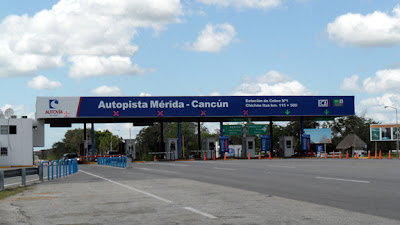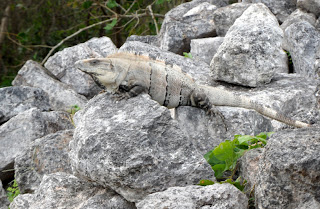As I am wondering the neighborhoods, the most gorgeous bushes in full bloom every where are the bouganvillas. They are deep red, magenta, pale tangerine and even white in color, but they are pervasive, lush and beautiful in these lower and middle class neighborhoods and thoughout the streets of Merida. I will pop in some photos of houses and streets I see on my trek.
I had heard that there was a fabric store about 8 blocks from my casita, so mid-day I set off looking for it. I headed due east until I hit Prolongacion de Paseo de Montejo, the extension of the El Centro street that boasts the most beautiful renovated Colonial mansions, museums, and expensive shops & bars. The Prolongacion end of it is certainly less spectacular, featuring every known brand of car dealership, a WalMart, an Office Depot and lesser shops, including, yes, a large fabric store! There were rows of fabric on bolts displayed, and it had obviously been busy during Carnival, now over, because most fabrics were highly impractical with sheens and glitters, feathers and tiaras were abundant as well. Yes they has zippers and buttons, cheap plastic beads and threads, a few needles and pins. I only bought 6" of velcro for about 10 cents! Ah such a big spender! I was actually shocked at how cheap it was!!!
Having made one discovery, I walked on down the Paseo wondering what I'd find next. A Mexican version of Staples caught my eye, so I went in to see what sort of pens and notebooks, computer peripherals, etc. I could find. And I walked away with a plastic binder and a roll of packing tape (for that package I hope to send home soon).
There was also a Mexican supermarket along the way, so I went in to see what they had and found some black shoe polish for my VERY scuffed pyramid-walking shoes. Three years ago when visiting Antigua in Guatemala, I couldn't even get out of a park bench without some 12-year old insisting that I VERY BADLY needed a shoe shine, something I could hardly deny. But I have yet to be accosted by a shoe shine boy, so I thought it best to take matters into my own hands! And I'm still wearing the same Mary Jane style shoes, originally rescued from Crestone's fabulous free box about 5 years ago! They drink polish like Mexicans down tequila!
Leaving Montejo for quieter residential streets, and taking a different route back toward Avenida Technologico, the main street close to my house, I decided to head for the giant "Mega Commercial" grocery store that is an easy bus ride back to my casita, to pick up some supplies while I was "out and about". This store has the fluffiest chocolate croissants for about 60 cents, yummy with morning coffee!
Cheese has been a bit of an exploration. There are some favorites like Philadelphia cream cheese (but in smaller boxes, and sticks of butter are smaller too), and some wrapped American Monterey Jack and such, but the only Muenster I have seen was at Costco (only I don't have a members card so I can't buy there), and the variety of quesos is quite extensive, but totally unknown to me, some of it is not refrigerated, which makes me wary, and all in all it's very white, looking like fresh mozzarella. I generally pass on it out of ignorance. However, today I found a small block of Feta cheese, so I brought that one home with me. I couldn't find tofu there, although I saw it somewhere else, only I can't remember where. Tofu that has been marinated and baked can sometimes be had at the Saturday Slow Food Market, which is moving from 2 blocks away to about 20 blocks away next Saturday. (I'll do a blog on that some other day.)
But I had a mission in mind.... to find hydrogen peroxide for my gums, as I am getting some dental work done (another blog story) and I cannot stand Scope and "tasty" mouthwashes. So I went to the pharmacy part of the store where 2 young men and a woman were wearing white hospital jackets, so I assumed they had some chemistry background, and asked for Hydrogen Peroxide, Agua Peroxide, and even wrote H2O2 on a piece of paper, but that struck a blank, the usual response when I don't have the correct term in Spanish. I did a little charade of swirling water in my mouth and spitting, and the young woman suggested Agua Oxygene, which I thought sounded promising. Sure enough, the label had peroxide, or a form of the word on it, so I bought a bottle... another successful find!

Here is the mural outside the Engineering College that is on the main street leading south to El Centro and north to the beach/port town of Progresso, Calle 60, also known as Avenida Technologico.... because of this fine school.

































